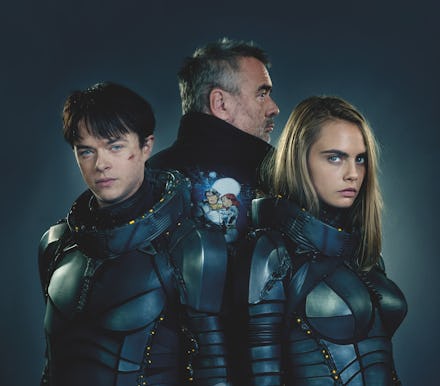This iconic French comic is the unsung inspiration for your favorite sci-fi blockbusters

"Luc Besson is probably freaking out right now!" said Hannah Stevens, who clearly can't contain her own excitement. "He gets to direct Valérian and Laureline!"
Stevens is working the counter at New England Comics, in Harvard Square, and we're talking about the French director's upcoming Valerian and the City of a Thousand Planets, an adaptation of the beloved French sci-fi comic Valérian et Laureline. Besson, whose cult space opera The Fifth Element came out 20 years ago, may not be freaking out right now exactly — after years in development, the film's set for a July 21 release. But hardcore sci-fi and comic fanboys and fangirls like Stevens are definitely losing their shit.
That's because they know the long-running comic, although unknown to many American sci-fi fans, hugely influenced the narrative tropes and visual palette for a generation of science fiction that followed — yes, Star Wars included.
Valérian et Laureline follows the adventures of its 28th-century namesake hero and heroine, agents of the Spatio-Temporal Service who travel through space and time to safeguard the Terran Galactic Empire. Written by Pierre Christin and illustrated by Jean-Claude Mézières, the comic debuted in Pilote magazine in 1967 and appeared in print until 2010. Bound collections have sold millions upon millions of copies and have been translated into more than 20 languages.
Besson hasn't been shy about his deep love for the comic. He invited Mézières to be a conceptual artist for The Fifth Element and joined him in a roundtable conversation at New York Comic Con in 2016, where he rhapsodized about the comic's importance.
"Reading those stories was like building your imagination, your sense of beauty," Besson said. "Probably the first woman I fell in love with was Laureline when I was ten."
If you've never heard of it, don't feel bad. Although Valérian et Laureline is big internationally, it remains a niche favorite among American comic fans. The first volume wasn't translated into English until the early '80s, and only a smattering were translated before 2010, when UK-based Cinebook began publishing a series of translations in the run-up to the film's release.
"As someone who was going to a specific comic arts program in the late 1990s and early 2000s, I [had] never heard of it," said Dr. Sarah Zaidan, assistant professor of visual and media arts at Emerson College, as well as a video game designer, artist and superhero scholar (yes, that's a real thing, and yes, her classes are as popular as you'd expect). "I certainly don't remember it being mentioned in our textbook. It's a pity because it's so influential in the science fiction genre."
Arriving the year before the May 1968 social revolution erupted in France and helped galvanize the country's Women's Liberation Movement, Valérian et Laureline reflected the progressive idealism of the time. Like Star Trek and other liberal humanist sci-fi, it used a fictional future as a way to address present-day social and geopolitical realities: the melting of polar ice caps in The City of Shifting Waters; gender equality in World Without Stars; and the plight of indigenous peoples under colonial rule in Welcome to Alflolol (a major theme in James Cameron's 2009 film Avatar).
Although endowed by her creators with the kind of comic-book beauty that inflames the adolescent fantasies of heterosexual boys, Laureline is a pioneering female protagonist in the world of sci-fi. Initially submissive to Valérian in early stories, she becomes more independent, often rebelling against the authorities of the Terran capital, Galaxity, and questioning the ethical choices she and Valérian are forced to make on their missions. Played by Cara Delevingne, the film's Laureline is an equal partner to Valérian (played by Dane DeHaan) who repeatedly rebuffs his incessant romantic propositions.
"As time goes on, she becomes more and more assertive," Stevens said of the comic's heroine, noting it was still rare at the time "to have a female character where she's basically on equal standing as the male protagonist."
If that brings to mind a certain princess-turned-rebel leader from a galaxy far, far away, well, sci-fi fans have been enumerating the uncanny echoes of Valérian et Laureline they see in Star Wars for some time.
However much it may have inspired — directly or indirectly — George Lucas or his creative team, the world of Valérian et Laureline, with its panoply of intergalactic species and lived-in tech aesthetic, seems both completely familiar and totally foreign. "I don't think I've talked to anyone who's a fan of sci-fi and did not like it," Stevens said. "It has all the fantastical elements."
Besson appears hopeful that his film version will strike a similar balance. Recalling at New York Comic Con the rather puzzled reception The Fifth Element got from American audiences in 1997, he suggested that audiences today likely won't find the world of Valerian all that strange.
"I think the difference from where I was with The Fifth Element and the American audience was kind of far," he said. "But now with this one, I'm still crazy but the world gets crazier."
Watch the new trailer for Valerian and the City of a Thousand Planets below.